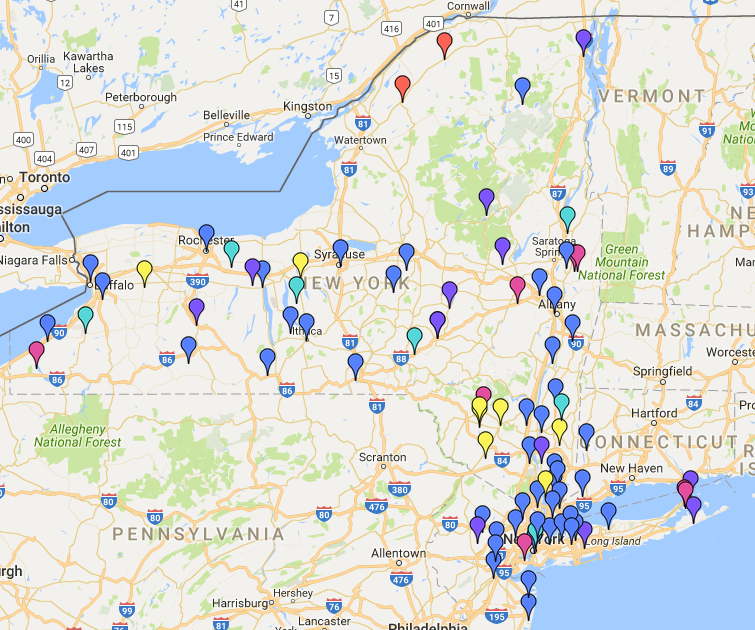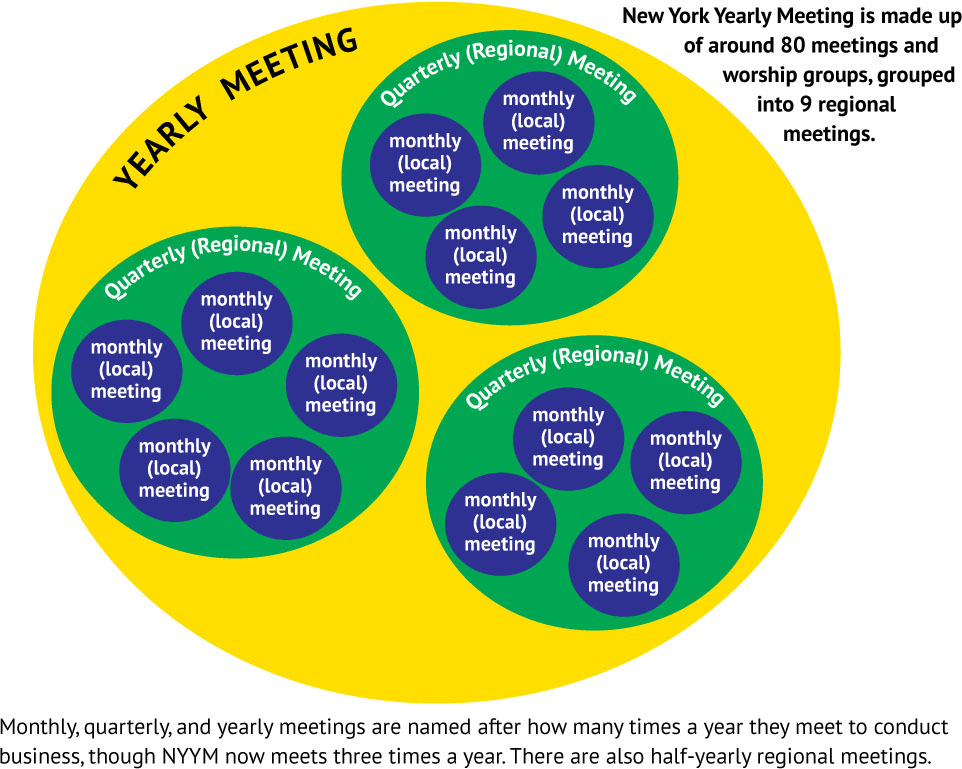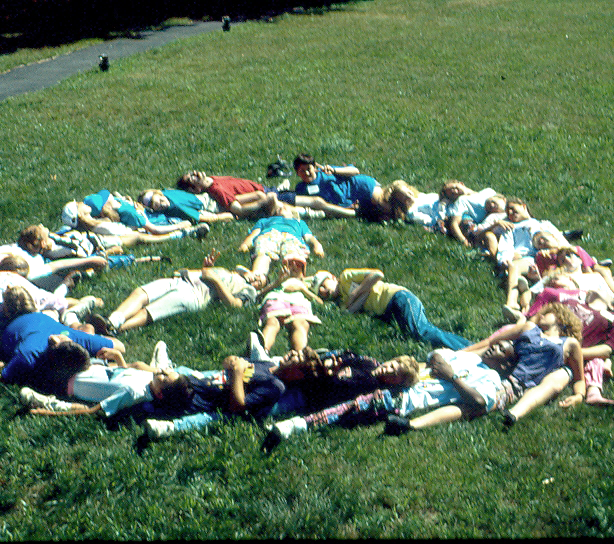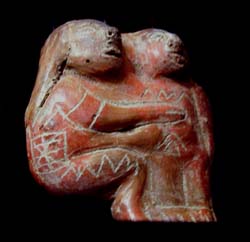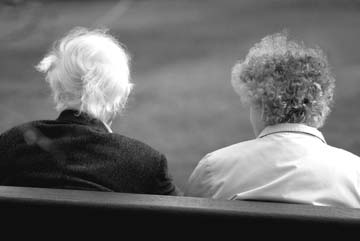Spark, March 2011
| SPARK 15 Rutherford Place New York, NY 10003 |
||
| New York Yearly Meeting News | ||
| Volume 42 Number 2 |
The Religious Society of Friends (Quakers) | March 2011 |
| Editor, Paul Busby | ||
Contents
Intimate Relationships and S-E-XVonn New, Bulls Head-Oswego Meeting In the summer 2007, I had recently moved to New York state from Florida and was attending NYYM Summer Sessions at Silver Bay for the first time. I seated myself in the big auditorium for business meeting. Since I didn’t know many people yet, I felt more like an observer than a member of the body. After some business, the clerk announced a threshing session and presented a query. I don’t remember the wording exactly, but I remember that it was to be about “gender issues.” That puzzled me, because I hadn’t seen any evidence of discrimination against men or women. After several people stood and spoke about “gender relationships,” it dawned on me that we were talking about sexual orientation and that we were trying, very obliquely, to discuss the sexual-ethics portion of Friends United Meeting’s personnel policy without using the word sex.
When I agreed to coordinate this issue of Spark on sexuality and spirituality, I knew, because of what I had seen of Friends’ reluctance to talk about sex, that I would have my work cut out for me; but it felt important to me to try. Indeed, it did turn out to be difficult. Most of the Friends I talked with about it told me that they didn’t know what they could say on the topic. Others said they felt afraid that what they had to say would not be well received by other Friends in the Yearly Meeting. Thankfully, Helen Garay Toppins volunteered to help out and suggested that we expand the topic to include information about intimate relationships and about help to couples. I feel that it is important that we become more comfortable talking about sex and making space for such conversations for several reasons. This Spark, then, explores a wide variety of topics related to sexuality and spirituality. And even more articles appear exclusively on the NYYM Web site, including “Sexual Healing” by Tara Greenway and “Whatever Ye Are Addicted To” by John Edminster. In my own life, I know that sexuality and spirituality are fundamentally intertwined. At the age of 35, I “came out” as lesbian. When I use the expression came out, I am really referring to an awakening that transformed my life not only sexually but aesthetically, artistically, economically, and spiritually. By embracing rather than repressing my sexuality, I was able to become aware of gifts that I didn’t know I had and open myself to new friends, new ideas, and new kinds of relationships and to experience with fullness the brief lifespan I’ve been given. None of this was because I am lesbian; it was because for the first time I was being intentionally true to my whole self and in doing so becoming open to and aware of a larger, wilder mind. Because what I knew to be true for me was and still is outside of the traditional moral codes I was handed as a child, I had to reexamine and discern a new set of ethics for my sexual behavior and intimate relationships. Honesty, respect, and being emotionally present, rather than sexual exclusivity, have become the way I define fidelity. By becoming aware of the power dynamics of intimate relationships along with issues of ownership, obligation, and responsibility, I have learned more about the Peace Testimony within the context of the emotional vulnerability that comes with sex than I have in any meeting setting. By sharing openly with others who agree to also share openly, I have learned that perceptions and experiences vary greatly from person to person and learned to find great delight in our differences. Because the gender of my intimate partners has become less relevant, I’ve found myself freed from the strictures of society’s gender norms and more comfortable being myself outside of the usual definitions of masculine or feminine. In my monthly meeting, Bulls Head-Oswego, we set about examining our attitudes toward sexuality as part of a process of becoming clear in our leadings regarding our relationship with the rest of FUM. We started by considering a minute that would welcome individuals and their ministries without regard to sexual orientation. When it became clear that we would not simply approve this right away, I was at first disappointed and even felt defensive and hurt. As we continued to labor, however, I finally came to understand that it was the conversation itself that was important rather than the end result. Friends across generations and of different sexual orientation and relationship status were able to ask questions that had been considered too embarrassing before and to talk about subjects that had been taboo. In the end, this is the minute that we approved: “In a predominantly heterosexual world, even where society has become more open to various gender differences, barriers remain for non-straight people. On entering a new group, these people must often test the waters to see if they are truly included. “Bulls Head-Oswego Monthly Meeting affirms the traditional testimony of equality of the Religious Society of Friends, and includes in that testimony people who identify themselves as bisexual, gay, heterosexual, lesbian, or transgendered. We seek that of God in everyone and welcome all to worship with us. We strive with Divine assistance to recognize and honor the intrinsic value of all forms of sexual orientation, gender expression or gender identity. “We approve this minute, and we note that we find much of the disapproval and intolerance for diverse sexualities in our culture irrational. We plead, not for total sexual freedom, but for broader awareness and more profound thinking about the complicated issue of sexuality.” When we worship together, we are spiritual beings in bodies bonded together in an incredibly intimate container of prayer to form a larger corporate body. When we each bring more wholeness to this worship—and sexuality is a part of that wholeness—then the corporate body itself is more whole and alive. I have heard many Friends describe their experiences of worship as having sensory manifestations in their bodies—trembling with a message, hands burning with compassion, breath quickening, etc. Without being lustful, this quickening of Spirit resembles sexual arousal as we surrender into the experience of a gathered meeting. What could be more ecstatic than that? Why not shed our remnants of gray and start describing meeting for worship as “sexy”?
Whatever Ye Are Addicted ToJohn Edminster, Fifteenth Street Meeting Friends,—Whatever ye are addicted to, the tempter will come in that thing; and when he can trouble you, then he gets advantage over you, and then ye are gone. Stand still in that which is pure, after ye see yourselves; and then mercy comes in. After thou seest thy thoughts, and the temptations, do not think, but submit; and then power comes. Stand still in that which shows and discovers; and there doth strength immediately come. And stand still in the light, and submit to it, and the other will be hushed and gone; and then content comes. And when temptations and troubles appear, sink down in that which is pure, and all will be hushed, and fly away. Your strength is to stand still, after ye see yourselves; whatever ye see yourselves addicted to, temptations, corruption, uncleanness, &c., then ye think ye shall never overcome. And earthly reason will tell you, what ye shall lose; hearken not to that, but stand still in the light that shows them to you, and then strength comes from the Lord, and help contrary to your expectation.… Some of us Friends have addictions we don’t talk about, and some of these involve our sexuality. Ones involving sexuality tend to evade our programs of self-scrutiny or moral inventory because they come upon us when we seem to be “not fully ourselves,” for example when we wake alone in the dead of night. Then we may take pleasure in imagining things that, if fantasies came true, would cause devastating damage to our relationships, our public image, and our conscience, not to mention the injuries they’d cause others. For many of us this is a nonissue, for we feel, and perhaps rightly, that it’s discipline enough to govern our tongue, our temper, and our outward social behavior. Don’t ask us to be stewards of our thoughts also! We’re not ready! True, we may feel discomfort from having a divided will, with most of our heart reconciled to our lot, but another part subject to wild yearnings for that beautiful stranger we saw on the train today, or our neighbor’s partner—and though we acknowledge this discomfort with our own disunity, yet it’s the last thing we’d want to part with! Some part of us—the ego’s great lie—thinks that our manliness or femininity, our self-worth, our freedom depends on our keeping this wild streak in us untamed. So we sigh for the forbidden fruit even as our lips say, “Thy will be done.” But if we scrutinize this pride in our own dividedness, we’ll find that it merely comes down to fear of letting ourselves be defenseless before the Divine. There may also be some unconscious strategy at work in our keeping a sexual addiction, obsession, or troublesome secret alive: for example, my having a plausible reason to condemn myself as a disgusting evildoer may serve to protect some loved one, perhaps a shadowy parent-figure from my early childhood, from the full force of my anger. Or my having a sexual “hang-up” to focus on may keep my attention off an untenable job situation, a soured relationship, a wasted life, or impending death. Only the firm will to have all dark things brought to light will make things come clear to us. Fortunately, at some point we may find it just too painful to be one thing on the outside and another on the inside, and in this lies our hope of healing. At some point we may want to outgrow the Jekyll-and-Hyde double-mindedness that keeps us wandering in existential futility. We may be sick of pining for others’ love while feeling undeserving of love, and so unable to be warmed and fed by love if it were offered. And the fantasies that once got us “hot” now fail us, or even offend us with their untruth. And eventually some spiritual growth-tip in our heart sends out the signal: “Savior, if You exist and care about me, fix me. Unify me.” I’ve surrendered ownership of my mind and body not perfectly, but enough to have learned how tenderly and respectfully God has treated my erotic neediness! As my Savior promised (Matthew 11:30), His yoke is easy; He hasn’t taken away my freedom, but given me freedom. He hasn’t had to wither my heart, my reproductive organs, or my sense of humor. He hasn’t shamed me for my raw lusts, but rather helped me see where they come from. Projection, fear, and misdirected longing for a lost paradise play their part, but in every case there’s a core of love, or of yearning for love, that’s holy and to be honored: “I see that you love her. Why not pray for her happiness? That’s a lawful thing to do with the energy that’s making your heart ache.” He’s been a very good shepherd when I’ve needed one: in a moment of temptation to adultery I once heard the word “No!” ring out in my mind like a shot, forbidding even a thought-experiment about what might happen next. At other times He’s surprised me by lightening my burden: “That sin is forgiven—put it away!” I heard this once in meeting for worship, and it soon dawned on me that all my sins were forgiven. After my wife and partner of thirty years terminated our relationship, and before I began my relationship with my present wife, I passed through a fall and winter of testing a possible calling to a solitary and celibate life, in which I forbade myself to be alone with a woman. One day in meeting for worship I heard His voice say “I will not let you fall into sin,” and I knew myself released to accept an invitation to be a woman friend’s house guest for the following weekend. As it turned out, God had work for me to do up there in the Litchfield Hills that my self-imposed prohibition would have stood in the way of. Then I suddenly found myself fallen in love with Elizabeth. I prayed for divine guidance, and moved forward rather than away. Since then, almost daily, I find reason to thank God for this gift to me of such a wise, loving, and deep partner. Of the providential wisdom by which I was called to a married life in Christ rather than a celibate one, I feel particular gratitude for sexuality’s way of keeping my heart tender and open toward all creatures. Would I have remained able to weep if I’d stayed single? For that matter, if I shared my home with a mere monastic roommate and not a beloved, would I have had all this marvelous spiritual exercise of mutual annoyance, mutual forgiveness, mutual prayer and spiritual counsel, as between equals, one of whom may one day die in the other’s arms? May all of us, straight or gay, find such blessedness in a monogamous bond! I feel a particular call to praise monogamy, having lived fifteen years, before becoming a Friend, in a commune that practiced open marriage while striving for enough emotional truthfulness to make this sustainable. (It burned me out.) What are we to do with our impulses to take many partners? Briefly, say no to them: and not merely because some outward authority teaches that those impulses are wicked, but because, even if we could invent the most perfect, heartbreak-proof system for making community of sex partners painless for all, that system would keep our focus on transient pleasures of the flesh, disallowing us from looking up to see what better thing God offers us in eternity. All love, including erotic love, seeks an end to all separation of lover from beloved. Sex seems to promise that, but does not deliver—not really. God, however, offers us the perfect fulfillment of unity with God and with one another in eternity. If this were not so, Jesus would not have prayed for what God could not grant (John 17:20–23). Whatever Jesus of Nazareth was, He was neither fool nor liar.
IntertwiningTara Greenway, Brooklyn Meeting Well, I am so glad someone finally asked. I have actually written a book about the way sexuality and spirituality intersect and intertwine, like a beautiful snug braid. This twining and crisscrossing could be good or bad, depending upon your definition of God and your definition of sex. Let’s assume, using my own life for an example, that the intertwining is bad. Quite bad. But when something is bad, it presents an opportunity to examine oneself, one’s definitions—to bring them out into the Light and examine them. It is an opportunity to perhaps unbraid these things, loosen them and toss them around a bit and let them flow freely, and ultimately, in the fullness of time…heal. As I did. What happens when two sections of the braid, your mind and spirit, are in direct and passionate opposition to the third section of the braid, your body? What if your spirit was taught since childhood that sex is sinful? What if your mind has, somewhere between Sunday school and youth group and family devotions and Baptist college, drawn the conclusion that God is the opposite of sex? What happens—and this is a really good one—if your body gets so confused by all this that it doesn’t know the difference between sex and pain? With me, what happened was that throughout my teens and twenties I resolutely avoided all things sexual, because, though there were a few boyfriends I liked, what I wanted above anything was to be pure. Holy. And everything I knew had taught me that sex was not holy—beginning with the Jews of the Old Testament, who would prefer for men not to look at women lest the men be defiled; continuing with the writer of most of the New Testament, Paul, who cautioned men that it would be better not to marry or allow women to speak out loud in church; through St. Augustine, who considered sex to be, and I quote from his delightful Confessions, “the filth of concupiscence…the hell of lustfulness.” The Wesleyans, Baptists, and Nazarenes whose schools and churches I based my life around seemed to pointedly agree. I think many of us had this same basic experience growing up, and, despite sex ed classes and Jersey Shore, many kids are still having it. But don’t worry about me. I escaped. It’s actually pretty easy to run away from the church; again, lots of people do it, all the time. But I desired something different: to run away from the church but keep God. This is trickier. In my late 20s I left the church I’d always loved, since it was oppressing me, and, because of how tightly that braid of mind/spirit/body was woven, the spiritual oppression began to manifest as physical pain. So I felt I didn’t have a choice. I was lonely on Sunday mornings, and very scared in general, but I left. And then I finally allowed myself to fall in love. After a while I decided, for the first time, that I would have sex, with this man that I loved. But I couldn’t, because the act itself caused excruciating pain. There were tears and psychologists and doctors and names of chronic pain conditions involved, but we don’t have space for all that here. What you need to know right now, so that we can get to the important part about definitions, is what happened in the weeks immediately after I’d worked through lots of things and at long last had sex. For one thing, I suddenly began to break glassware, crashing water glasses to pieces in restaurants, cracking cereal bowls at home. My mouth ran ahead of my mind: once I said “virgin” instead of “version,” another time “prostate” instead of “prostrate.” Though I was happy that neither the church nor a chronic pain condition had control over my body anymore, it seemed that I myself was giving up control also. So then—who was in control?
This is the question that brings us to the definition of God. If one’s definition of God is that of a perfect and fearsome father with a huge set of rules to follow in order to be worthy of Him, then premarital sex would further separate us from God. But what if nothing could separate us from God? What if Romans 8:38 is true, where it says that nothing—“neither death nor life, neither angels nor demons, neither the present nor the future, nor any powers, neither height nor depth, nor anything else in all creation”—can separate us from God? And what if it is true—here’s the crazy part—because God is already in the very center of our being, braided in with us? What if we can be separated from God no more than we can be separated from our own bone marrow, or brain stem, or sacrum? What if Augustine got it a little wrong, and God is not disgusted by our bodies but is in fact a mysterious, invisible part of them, of us? (This is a little concept that is sometimes referred to as the Holy Spirit.) If truly nothing can separate us from God, that would mean that sex—intercourse, the intermingling of the inner places of two bodies, both of which contain at their core God—would be the intermingling of two tiny parts of God. That would be my new definition of sex. It seemed pretty good. The fact that babies are produced from sexual intercourse always made me take sex more seriously than most (non-Baptist) people seemed to. It seemed like a huge cosmological hint: “Psst…from sex comes new life. Think about it.” Good sex might be fun, but it was clearly something more than that too. With these new definitions of God and sex, the link to creating life made perfect sense. It is powerful enough that the Godness of the universe courses through invisible veins in every individual. When the inner fluids of one body strike the inner fluids of another, the resulting energy must be amazing, profound, and highly reactive. If these definitions of God and sex were accurate, then wow—I could see why the early Jews and Christians made up so many rules about sex and that acutely sexy gender, women. I could see too why the Christians of the 1960s and ’70s reacted so strongly against the free-love movement the rest of the country was experiencing. The Christians were frightened of the power of sex, and they understood its import. It’s just that paradigms based on fear never quite work, since love is, as the Bible tells us in 1st John chapter 4, stronger than fear. So the love people will win out over the fear people every time. The free-love movement of the late 20th century also missed an important part of the definition of sex, of course. The Christians missed the joy part of sex, and the hippies missed the God part. Love really is free, but that doesn’t mean it’s random or interchangeable. Love is divine; love is of God. “God is love,” you know (1 John 4:16b). How can we treat sex as anything less than a sacred, joyful, precious interchange? I had wondered who was now in control, since the controls of the church and the further controls of the pain from my own body had been removed. I didn’t know yet that the idea of controlling sex, which assumes that there is something out of control about it, was inaccurate. Because, you see, when you have a definition of sex that is on-target, sex has a natural ebb and flow, like love, like the tide. It doesn’t need rules. When accurate and aligned, sex has an inherent natural order. It flows. What makes the tide flow? The moon. What makes the moon make the tide flow? Well, you know. For lack of a better word—God. Much of the above article has been adapted from Tara Greenway’s unpublished spiritual memoir, Sex and God in the City, and is under copyright. Please do not replicate without permission. Tara is a member of Brooklyn Monthly Meeting and does mind/body healing work in Manhattan; her practice is explained at www.energyopen.com.
How Are We Teaching Our Young Friends?Susan Hannigan, Morningside Meeting When I was approached to write an article for this issue, no one had yet submitted anything, possibly because the subject is sexuality. I wanted to understand why we are collectively so uncomfortable talking about something that is so fundamental to all of our lives. So I reached out to a variety of people I know who grew up in the Yearly Meeting, ranging in ages from mid-30s to early 50s, who as young people attended monthly meetings, Quaker schools, youth programs, and Silver Bay and asked them about what they observed of Quaker adults as they came of age. In cramming as many interviews I could in to a holiday weekend I began to get some clear images of how we relate to these subjects. The good news: Quaker adults get overwhelmingly excellent reviews on passing on factual information about sexuality. The vast majority said they had excellent knowledge about the science of how their bodies work (where babies came from, adolescent body changes, birth control, etc.) from very early ages. We knew how to keep our bodies safe. “I think I was very lucky to grow up in such an environment. As an adult I would talk to friends who grew up in conservative religious environment and I would hear these stories about shame and guilt about your body. I never had a moment of feeling that kind of thing.” Well done, grown-ups. Now the downside. Of all the people I talked to, no one remembers having a conversation with the significant adults of our lives about the emotions connected to sexuality and relating to your body. No one. While many of our parents had copies of Our Bodies Ourselves and The Joy of Sex on their bookshelves, we were clearly supposed to view these like guide books of places we were not supposed to visit. “The main thing that springs to mind with this is the inconsistency I saw between my father’s religious beliefs and his philandering. Also recall him refusing to let me get a diaphragm in high school.” “They were raised learning about sexuality in locker rooms. They assumed we would do the same.” The testimony of integrity often came back to haunt the adults in our lives and how we saw them. Many of us were raised to expect a higher level of truth from Quakers. When Friends fell into the all too human pitfalls of infidelity, sexual harassment, and boundary crossing, many of us felt especially betrayed. Another mixed message some of us received was that of what one person called “The gray area of sex.” The feeling was that you were supposed to either be completely abstinent or you were having sex. Several women I spoke to talked about a lack of support from the community in finding their own pace. “No one ever explained that I was in charge. That I could enjoy my body with someone else and then stop when I wanted to. Because I didn’t get that message, and I was afraid that every thing would lead to sex, I didn’t have as much fun as I wish I had.” “No one told me the value in holding on to my body and sexuality. I knew where to get birth control, but I didn’t know how to figure out when and if I wanted to share myself. We were without any support system for that. We were told to wait until we were ready. When was ‘ready’”? In observing adults we noticed the disappearance of physical affection as they got older. Many of us experienced remarkably safe physical lives with each other as teens. In youth programs we could be exuberant with our expression of physical love for each other and not fear retribution for it. However, as adults, affection between friends turned into an almost unpleasant thing. Adult Quaker hugs were described as “cold” “rigid,” and “unwanted.” “The only people I ever saw genuinely hug one another with enthusiasm were the lesbians. And even that had a political, in your face edge to it.” One friend in recovery says, “It’s the alcoholics who hug well, not the Quakers.” Body image among friends became a heavy subject at times. Many of us felt liberated by simplicity and equality when it came to physical presentation. To not have to buy in to the mainstream view of the physical ideal and the materialism associated with high fashion was a gift and a relief, but once again we missed the gray area. In describing how we saw adults’ relationships to their bodies, “asexual” “shut down” “a lot of unhappy people in unhappy bodies” were the descriptors. Women who grew up on our community talked in strong extremes ranging from liberated to intense guilt about wearing makeup, jewelry, or beautiful clothes. “It was a badge of honor to not care about your body.” “I went through a phase where I couldn’t understand why anyone would want to dress up. I was almost disgusted by it.” “Ugly is beautiful.” Women who did make efforts to make themselves feel physically special were often admired but with conflicting emotions. “To see a woman who wore nail polish or great earrings was amazing. It was like she was breaking the rules. Like you were risking something if you were celebrating how hot you were.” “... because Quakers strove for equality... alluring men and women seemed to not be playing fair.” So where does that leave us? Do we want to be a religious body that seems to want to have nothing to do with our bodies and value only what is from the neck up? To think of affection and warmth as being only for the very young? To be leery of those who express joy and pleasure? To make men feel guilty for their testosterone? I think we deserve better. If God has given us the sensory ability to touch, taste, smell, hear, and experience our bodies fully, aren’t we denying that of God within ourselves when we deny that essential part of ourselves? I end with some queries about the body and pleasure. I would suggest taking time by yourself to answer them and then think about taking the risk to share them with a person you trust. I am thinking that part of our healing process as a group is to start as individuals and then share with each other. To take the risk that our physical experience is maybe not so risky. That maybe the times we are aware of our bodies and share them with others is what makes us human and what makes us divine. ● When is the last time you did something physical that made you feel fully alive and in touch with your body? The last time you exercised or did some form of physical labor that made you break a sweat? Put on music from your youth and danced around the house? Got a massage? Curled up with a cat or dog, stroked its fur and matched its breathing? Cuddled a loved one? Let yourself have a long bath rather than a quickie shower? ● Do you have a piece of clothing that makes you feel very attractive? What does it bring out in you? When was the last time you wore it? ● When is the last time you had a meal of food that you truly love? When is the last time you had such a meal where you slowly ate every bite so you could taste every flavor? ● Who is someone you physically admire and find attractive? What qualities do you enjoy about this individual? ● When is the last time you took very good care of your body? What can you do right now to cherish yourself?
Sexuality and Spirituality: What Canst We Say?Christopher Sammond, Bulls Head-Oswego Meeting The Buddha was reputed to have said that if there had been another drive as strong as the sex drive, he would not have achieved enlightenment. Most Christians understand Jesus to have been both fully human and fully divine. Yet most Christians also view Jesus as having been asexual. Did His full humanity not include sexuality? Those called to devote their lives in a singular fashion to their faith, living monastically, in both Christian and Buddhist traditions, have renounced sex as a barrier to spiritual attainment. In the Hindu tradition, there is the full range from sex being used as a path to spiritual development in Tantric Yoga to sex being given up in the vows of the brahmacharya, as Gandhi did. In the Jewish tradition, it is a mitzvah, a blessing, for a married couple to have sex. If they do so on the Sabbath, it is a double mitzvah. All the great religions have something to say about how sexuality and spirituality mesh, or don’t. To paraphrase George Fox, “What canst we say?” If we look at the Faith and Practices and books of discipline of most yearly meetings, we find very little about this crucial aspect of being human. I imagine that a great deal of this absence is due to cultural reticence; we are uncomfortable talking about such deeply personal matters. And I imagine that another good reason for this void is that we know that coming to unity would be arduous, if not impossible. In this yearly meeting, I have heard that we strained the fabric of our community, and did much harm to each other, in the 1980s and ’90s while weighing how same-sex relationships could be represented in our Faith and Practice. Friends here refer to those days as “the culture wars.” Trying to come to a common understanding almost tore us apart. We had agonizingly painful business sessions of great dissension and harshness. Articles were published that did great harm. For years there was no unity but much very heated debate.
At the same time, I have witnessed a deep hunger in Friends to talk about sexuality and its integral connection to spirituality. In the late 1980s I led a men’s workshop on sexuality and spirituality, and the hunger that those men had to talk about sex in genuine, meaningful ways was astonishing. Twenty years later, it is still palpable. I recently had a conversation with one of the other authors in this issue, assuming that women had those conversations much more than men did and that therefore women did not share that same depth of hunger, but she told me that she thought it was the same. How can we meet this hunger? Is it possible for us to come to any common understanding on sexuality that we might add to our Faith and Practice? Philadelphia Yearly Meeting looked at the latter question in the 1970s, and appointed a group of Friends, who met one weekend a month for, I believe, three years at Apple Farm. The Apple Farm Group committed a significant part of their lives to explore what sexuality and spirituality meant to them. At the 1987 FGC Gathering, they had a reunion and panel presentation, which I attended. The experience had changed all of them deeply. Marriages formed and broke up in those three years. Many assumptions about life were challenged and changed. I remember quite well the conclusions of two of the presenters. They each said that they would no longer be willing to engage in sexuality outside of a committed, long-term relationship but that it took each of them a long journey to get to that place. I believe that you cannot separate sexuality and spirituality, though our society is rife with messages that it is possible to do so. (The most recent one I have seen is an ad about a new TV show. The premise is: can best friends be sexual partners and not wreck the friendship—or become attached to each other?) To be sexual with someone touches the core of our being, whether we intend this or not. Touching that core is a spiritual act. In opening deeply in corporate worship, we touch that same core and let it join with others. When I worshipped with Twin Cities Friends Meeting, I would often sit next to a friend whose depth of worship tended to bolster my own, and vice versa. Sometimes after worship we would ask, half-jokingly, “Well, how was it for you?” Being that open, not only to God but also to those around us, is a communion that we as Friends recognize and celebrate. And I find that communion to be very similar to that which occurs in sexual union when Love is present and hearts are open. But we don’t often talk in terms like that, either about our spiritual experiences, or what we have learned about living out Love in our sexual lives. Those Friends in the Apple Farm Group could say what they had learned. They could share the benefit of their experience. And PYM has a section, admittedly brief, in their Faith and Practice on sexuality and spirituality (http://archive.pym.org/publish/fnp/fnp04-pages_65_to_81.pdf). I believe that this yearly meeting has healed enough from “the culture wars” to venture forth again into those challenging waters. What canst we say?
Two Sides of the Same CoinRuth Matthews, Chappaqua Meeting The concept that spirituality and sexuality are two sides of the same coin is not a new idea. The Hindu religious tradition has long had a branch that believed sexuality could indeed be a door to experience of the Divine, and used sexual union as a serious spiritual practice. The Kama Sutra, originally compiled in the fourth century CE by a Brahmin and religious scholar named Vatsyayana was based on texts dating back to the second century BCE. And there are renowned temples in India dedicated to the celebration of erotic love. As our world continues to shrink and intermingle, these ideas have begun to infiltrate and permeate our Western culture, which has historically regarded spirit and body as two separate and opposing entities. This split between body and spirit is, I believe, responsible for many of the distorted messages about sexuality that permeate our culture. This split manifests itself collectively in a variety of ways, from sexual malfunction and promiscuity to eating disorders to our rape and abuse of the earth. I have come to believe that understanding and healing that split is a necessary part of our spiritual journey if we want to be more open, loving channels of “that of God in everyone.” And perhaps the evolutionary leap we need to make if we want to continue to survive and flourish on this beautiful, amazing planet that we inhabit. If we think of sexuality as “life longing for itself,” then it is not hard to conceive of sexuality and spirituality being a conduit one for the other. Therefore, I would offer some resources that might be helpful for exploration of this aspect of spiritual journey. 1. The Complete Kama Sutra (translated by Alain Danielou) is a modern translation of this classic Indian text. Danielou writes “Eroticism is firstly a search for pleasure and the goal of the techniques of love is to attain a paroxysm considered by the Upanishads as a perception of the divine state, which is infinite delight.” 2. For those interested in a psychological framework (and women in particular), the works of Marion Woodman might be of interest. Marion Woodman is a Jungian analyst who has focused on exploring feminine consciousness in particular, through dreams and myths. Her books include: Addiction to Perfection, The Pregnant Virgin, The Ravaged Bridegroom, and Leaving my Father’s House. BodySoul Rhythms workshops are also offered. All books, tapes, and workshop information are available from mwoodmanfoundation.org. 3. A more practical approach can be found in the works of David Deida. The author of several books—including Enlightened Sex, The Way of the Superior Man, and Dear Lover—and at least one excellent tape series, David Deida is known for his insights into masculine and feminine consciousness and his commitment to deepening genuine spiritual and sexual practice. His work is available from Sounds True, www.soundstrue.com. 4. Shalom Mountain, a retreat and study center in the Catskill Mountains near Liberty, N.Y., offers workshops in Spirituality and Sexuality at various times throughout the year. Shalom Mountain exists to call people to be conscious, loving and fully alive, and is committed to individual and global transformation through the creation of intentionally loving community. See www.shalommountain.com.
Evolution’s BeastJeffrey Aaron, New Brunswick Meeting Editor’s note: This is the full version of Jeffrey Aaron’s article. A shortened version appeared in the printed edition of Spark. What meaning in life is there outside of interrelationships with other life? It is in human interrelationships that the theologian Martin Buber said God could be found. “Meaningfulness” and “God,” of course, are not the same thing. Meaningfulness can be negative; for example, some find “meaning” in revenge. A sexual relationship is a powerful interrelationship, and is usually full of meaning of one sort or another, but that meaning can range from the deeply spiritual to the deeply harmful. We are given sexual drive as an integral part of life itself, but no instructions how to deal with it other than what we can derive from guidance from others and from experience. I recall watching a nature program on television in which a male mountain goat would “typically” pursue the female unceasingly for weeks in anticipation of her estrus, in order to have the opportunity to mate. He did not eat or do much of anything else during that time, which was explained as the norm. The pitiful spectacle demonstrated the extremes of common hormone response, sometimes referred to as “testosterone poisoning.” On another program, a male elephant had become ragingly dangerous as a result of his “coming into rut.” These spectacles demonstrate that this natural biochemical “poisoning” is the standard process developed through evolution for the perpetration of many species, including humans. The sexual drive is powerful enough to cause males of various species to fight ferociously, sometimes causing enormous harm and even fatalities, just for the opportunity to mate. The element of guile is another common device in the courtship process. Humans use charm and other specific behaviors to achieve their goals, in the process often convincing themselves of their total sincerity, in order to appear sincere to the other. This self-delusional process can be observed in females as well as in males, though it is more present in males during mate seeking. It likely derives from the same hormonal influences. Acknowledging that biochemical makeup, including hormone levels, varies from person to person, what other factors modify the expression of a given individual’s sexuality? Every individual’s childhood socialization will have a significant influence on later behavior patterns. If a boy is raised to consider women inferior or “the other,” or “the enemy” or those who need to be conquered, adult attitudes and behavior will be destructive. And, of course, socializing influences are never solely from parents. If he is brought up to consider women respect-worthy fellow humans and potential sources of love and support, a constraint on sexual aggressiveness becomes an automatic part of that individual’s behavior patterns, especially if sexuality is associated with love, partnership, and spiritual fulfillment, as contrasted to conquest or to the simple physical need to be sexually satisfied with any female (which, of course, is generally an elusive goal for those with this spiritually incomplete perspective). Sexual orientation does not appear to be a major distinguishing factor.
A spiritual bent on the part of a given individual will greatly inform the nature of that individual’s sexuality. This does not refer to a religious bent in the sense of a relatively unquestioning membership in a religious community whose primary influence is social, with adherence to a pro forma set of values. I refer to a contemplative person, one who is conscious that the physical world is only one aspect of reality—a person whose relationship with others and with the world is a part of a life search for truth. The seeking for spiritual depth requires some contemplative time, which is difficult for those under the influence of these natural drugs. It can probably be safely assumed that many individuals’ contemplative efforts are thwarted at least in part by their sex drives, especially when a physically attractive person is in their midst. Those blessed by upbringing, culture, and examples that provide a holistic context to control these strong hormonal influences, can handle them more easily. They can manage them in the spiritual context of fuller human relationships. Nevertheless, many good people are aware of a beast within. This beast can be enormously difficult to control and truly frightening to perceive, just as it is enthralling to perceive one’s spark of spiritual unity with the world, including one’s sexual drive. Experiencing the various aspects of one’s sex drive is like personally observing the mythic battle between God and Satan, but within oneself, and thus that much more frightening and desperate a battle to try to control. Nor does it ever seem to be fully resolvable: controlled at best. I believe that those women who do not experience the grip of the internal testosterone-driven sexual dynamo have no concept of its power over, nor of its pervasiveness within, many, if not most, men. Some women, of course, experience more of this intensity and pervasiveness than others, just as some men undoubtedly experience less, and many women are indeed aware of the extent of its hold on many men. Generalizations concerning the apparent gender distinctions are not absolute just as hormone levels are not fixed. Human social norms, in which much greater control is expected over hormonal drives, must be recognized as not being entirely in line with nature. In this arena society attempts to rise above brute nature, and may find “the Beast” difficult to acknowledge as nature. When a man is unable to control himself in ways that society now requires (which requirements vary among different cultures and subcultures), society must protect itself from his destructive nature. And yet, society must also consider the factors that led to his destructiveness. As is the case with alcoholism, another “natural” concern, the causes range from biochemical to psychological, and often include both, and in any event reflect imbalances for which some level of understanding and compassion is appropriate. Of course, awareness and societal control are also indicated. As difficult as it may be to feel compassion for one whose behavior appears to lack that very quality of understanding and compassion, all forms of antisocial behavior reflect some form of damage to the soul (“psyche,” if you prefer) of the perpetrator, and the appropriate courses of action include both protecting society and treating the damaged person, just as it is universally recognized that the victim needs compassion and help. One jailed sexual offender requested that the state chemically castrate him because he believed that after his upcoming release he would inevitably offend again. He did not see it in his power to change his behavior. A healthy sexual relationship can be positive and deeply spiritually fulfilling for any two involved persons; an unhealthy one is destructive for both. While seemingly self-evident, this truism is not yet a part of the awareness of much of humanity. Widespread enlightenment appears to remain far in the future, as far along as we may have come in recent decades. A sign of a possible tipping point in society’s sexual and psychosocial maturity may be when most men become aware that the women’s liberation movement is truly a people’s movement, as meaningful for men as it is for women.
Nurturing RelationshipsRima Segal, Rochester Meeting Our sexuality is the life force coursing through us to continue the species. Societies have always tried to contain this force. What does our Religious Society say about it? Two yearly meeting books of discipline say the following. “Marriage is solemnized in God’s presence and nurtured with divine assistance in reverence and love. Couples covenant with God, their meetings, and each other to clarify and strengthen their commitments. When two people make their vows to each other in the presence of God and their friends, they take each other as lifelong partners, promising with divine assistance to be faithful to each other.” (New York Yearly Meeting Faith and Practice, 1998, p. 38) It goes on to say, “Marriage is a covenant intended for life, and it is with deep sorrow that we note divorce among members.…” and “The monthly meeting can also advise and counsel those who are overwhelmed by social pressures and confused by our culture’s conflicting attitudes toward sexual morality.” (both p. 39) Pacific Yearly Meeting (PYM) in its Faith and Practice (2001, p. 110) invites meetings to have a continuing oversight committee for all marriages within a meeting. They also have discerned that care for children’s spiritual well-being is a continuing part of the oversight committee’s obligation. We’ve all heard the saying “It takes a village to raise a child.” When I was a child the “village” knew us and took care of us and the community. I have often thought how sad it is that today’s children don’t have that kind of loving concern from people they don’t know. Our contemporary life is very different from the communal life of bygone eras, when everyone in the village knew what was going on in everybody’s lives.
We try to build community into our lives by forming associations, but the associations we form are composed of people like ourselves. We don’t intrude upon their lives, except when they invite us. People struggle by themselves. We live in silos without connecting bridges, so even when we want to connect, it is extremely difficult to cross the chasms that separate us from other individuals, let alone other groups. Our sexuality is the most private part of our lives. We open the box only a tiny bit when we announce in public what we intend to do in private at the time of a wedding. Gay people have recently brought their sexuality into the public sphere to demand the right to live in daylight without fear. But we don’t discuss sexuality openly in our religious society, and I think we fail as a meeting to guide our meeting children. In our NYYM Faith and Practice (p. 43) we have written: “As children and growing adolescents face the destructive pressure of culture and conflicting community values, particularly in sexual practices, parents should guide young people to recognize the importance of integrity by emphasizing the need for mutual trust and mature understanding in achieving a long-lasting intimate relationship. Parents will recognize that a truly committed sexual relationship is likely to be beyond the power of a young adolescent, and they will encourage abstinence.” Most people in our culture, and likely in our Society as well, have accepted the notion that it is psychologically damaging to ask or expect young people to refrain from sex before marriage. Our equality principle has led us to believe that girls should be as free as boys always have been in sexual affairs. During Vietnam our mantra became “Make love, not war.” No one wants to be thought a prude, so no case is made for abstinence, and we pity people who are abstinent; we discuss birth control instead. As a meeting, we do not intrude; we leave it to parents, and we do not know whether the parents agree with the paragraph quoted above. In the light of all this, I am filled with questions. How much privacy do we expect people to relinquish to our religious society? How much time are we willing to invest in one another’s lives? Do we expect one another to be willing to answer a probing question without anger or rancor? Do we believe chastity is possible and preferable before, during, and after marriage? How do we promote this value? Is the occasional letter to a couple under our care inquiring about their health, jobs, and children adequate? How do we know when they have difficulties? How can we help them tenderly when they do? We recognize that love can depart from a marriage; how do we deal with divorce among members? Do we hold clearness committees with a couple contemplating it (do we even know they are contemplating it?), or meetings to grieve and heal? Do we hold meetings to read Faith and Practice with our children and their grown-ups and discuss with them what we have written as our testimonies? Do we hold such meetings with incoming attenders, or do we merely suggest they might like to read Faith and Practice?
Just as there is that of God in every person, there is that of God in every relationship that calls upon God. – NYYM Faith & Practice
Couple EnrichmentMary Kay Glazer & Mark Moss, Ticonderoga Worship Group
If couples want to explore spirituality and sexuality in their relationship, they might want to participate in a Couple Enrichment weekend. Couple Enrichment for Friends, a ministry under the care of Friends General Conference, seeks to deepen the bond that committed couples share with each other. We have been leading Couple Enrichment retreats since 1999; this ministry is under the care of Rochester Monthly Meeting. We have a care-and-accountability committee that provides oversight and support and a travel minute from Farmington-Scipio Region and New York Yearly Meeting. Typically, a retreat is held over a weekend, and eight to ten couples participate. The weekend is primarily experiential, with couples focusing on their own relationships. We do not provide counseling—our role as a leader couple is to help build a caring and safe environment for personal sharing and to offer tools and insights that couples can use to deepen their relationships. (In addition to weekend retreats, we can adapt the amount of time to a community’s needs.) Couple Enrichment is based on three premises for a healthy relationship: (1) couples have a commitment to growth in their relationship; (2) couples need a healthy communication process; and (3) couples will benefit from approaching conflict creatively. Our retreats start with these premises and build from them. We affirm that couples have demonstrated a commitment to growth by coming to the retreat. We introduce a communication model and have couples use it throughout the retreat. We invite couples to use conflict as way to learn about themselves and their partners and to deepen intimacy between them. As Quakers, we see the tenderness of holding one another in the Light as a way to deepen our connection with one another. We find that when a group of couples shares in this retreat, the experience can be quietly transforming. Topics that may arise in a retreat cover a broad range. In addition to spirituality, these include anger, finances, sex, parenting, and how to have fun together. While many issues associated with these topics are challenging and possibly painful, the tenderness that arises in a retreat setting with a group of Friends is dynamic and can open new paths for a couple. We regularly offer Couple Enrichment retreats at Powell House. We also welcome invitations to meetings and regions throughout NYYM and beyond to host retreats. We can develop a retreat that meets a community’s needs, including special-topic retreats that might include a focus on spirituality, anger, or other topics. Sponsoring a Couple Enrichment retreat and paying for couples to attend a retreat are two ways a meeting can support marriages under its care.
We grow in both our virtue and our capacity to love by the testing, against the world and each other, of those weaknesses which by the grace of God we can convert into strengths; and by the finding of those strengths and beauties in each other which we hardly dared suspect were there. – R.B. Crowell, “Words at a Quaker Wedding,” Friends Journal, November 1974
Clearness Committees for MarriageJeffrey Aaron, New Brunswick Meeting I recall with fresh tingling of spirit and a remaining sense of awe after all these years, the first time I served on a clearness committee for marriage. It was not too long after I first served on my meeting’s Ministry and Counsel Committee, which was not all too long after I first became a member—at least not long from the perspective of some 30 years now. My recollections of the actual time, however, may be inaccurate as a result of the compression of the decades in my very human memory banks. Nevertheless, the significance of that experience remains heady for me to this day. With the kind of forward thinking that is not uncommon among Friends, the committee decided that it would be best if the clearness committee of two Friends for each member of the proposed couple be composed of as much variation as possible: I was the young male, paired with an elderly woman to visit the bride-to-be. We made a conscious effort for the other pair also to be composed of a man and a woman, a young person and an elderly. Whether we succeeded completely in our idealistic notion now fades in my memory; I no longer recall who served for the groom-to-be. The fact was that when I read up on the process, alone at home, I was suddenly struck with the fact that we—I—had agreed in effect to serve “in loco ministerium.” We had agreed to serve in the capacity of a traditional minister or priest, despite a total lack of experience or professional training! What does this mean? I thought to myself. Friends naively try to accomplish things that no sane person would be expected to attempt in “ordinary” society! What faith! What chutzpah! I was a young Friend, and suddenly, the implications of the responsibility felt very heavy on my shoulders. Does this mean that everything that we do as Friends together is equally imbued with that kind of responsibility? The idea spoke to me strongly about the implications of becoming a Friend; we are indeed agreeing to become ministers to each other. And that holds deep meaning for us all in all that we try to do together. Will I be a good minister? What are the ways that I can learn? Who can help me? Well,I thought, I had better live up to it. Two people were depending on our good sense and good judgment—for the rest of their lives, or hopefully so. This meant that I had to consider every aspect of marriage, think hard about it, and prepare myself to talk honestly and openly with the young bride-to-be, at the same time being kind and gentle and able to listen skillfully. The “hard things” must be on the table: money, sex, children…anything and everything. I must be open to consider the idea that we might not come out of the meeting with sufficient clearness, and what would that mean? What then? Was I truly up to such a charge? In retrospect, I probably was not, but I prepared as best I could and I did my best, with the good assistance of a seasoned elderly Friend. That was all that was required; it was a shared burden—shared by all the Friends who were involved. We were received with gratitude by both members of the couple, through the initial process and through the wedding itself under the care of the meeting. During the actual wedding, another aspect of that weighty responsibility arose to full consciousness for me as a relatively new Friend. As witnesses to the marriage, as Friends, and especially as members of the clearness committee, we were to share to a limited and shared extent in the responsibility not only of the clearness and the wedding, but of the marriage. The balance of their married years together was a live concern for the entire meeting—by definition. That was many years ago and was but one of many marriages since then. With realism about the world, it is now clear to me that couples often move far away; they change as people do as the years go by, and they may or may not wish to retain that relationship, or retain it to the same extent. In fact, they may not wish to retain the relationship with each other, and we cannot take more responsibility for what happens than is our lot. And what our lot may be is not always clear, especially as the years go by. As a meeting, we reach out however and whenever we can. Sometimes we may be required to let go. Our discernment is always that of people who are imperfect, laboring together as best we can in the Light. Keeping the right balance and the right perspective is not always easy. But what is clearly necessary for any healthy Quaker process is taking it all entirely joyfully seriously and responsibly, researching and learning and remaining open to the Spirit. That being a Friend gives one such an opportunity to grow still leaves me in awe and full of gratitude.
Sexuality and AgingAnita Paul, Schenectady Meeting
A woman, 55, says to her husband, “We’ve done enough of that, we’re not going to do that anymore.” A man whose medical issues prevent him from being sexually active refuses to hold his wife while she meets her needs. The young people who attend Powell House youth programs have opportunities to learn about sexuality and reflect on sexual ethics; those of us over 50 don’t have those times set aside to learn about and reflect on our sexuality and sexual ethics for the partnered/married. Just as we hope our youth get the sense that sexuality is not for predatory or selfish purposes we need to understand what that means when we are older and the challenges are different. As each decade passes we over-50s are acutely aware that our sexual drive changes as our hormones change. There is no particular decade when that happens, and even if our sex drive declines we remain, always, sexual beings. Our sexuality is intricately bound up with our sense of ourselves and our identity, and when sexual drive fades we often experience a sense of loss. Alex Comfort, the British gerontologist, said, “The only reasons to give up sexual activity in old age are the same reasons to give up bicycling: you can’t, you don’t want to, or you don’t have a bicycle.” If we do have a “bicycle,” we have responsibilities to that other person. The woman who ends her partner’s sexual life at 55 doesn’t understand her partner’s needs, is unwilling to consider them, or hasn’t perused the lubricant shelves at the local drugstore. The man who withholds cuddling warmth and tenderness from his partner has lost the chance to reinvent what sexuality could mean in the changing circumstances of their relationship. Both are making self-centered and one-sided decisions. Available to both men and women are herbal remedies that support sexual desire and performance. Be proactive. Perhaps some emotional therapy is needed. The last years can be the best. There are a number of books on sexuality and aging. Getting Naked Again by Judith Sills for women who are dating again after a long time; Sex and the Senior Woman by Gail Sheehy, which has sections for midlife and up; and Older, Wiser, Sexually Smarter by Peggy Brick, a workbook that includes chapters for both straights and gays. (I realize that there are no titles for men, but then, there is no Viagra for women.) Not only are we living longer, but better exercise and nutrition make us “younger” than our parents were at the same ages. Naturally this new “younger” old age has an impact on our sexual expression. This is uncharted and we need to read and to talk with our partners and with each other. We need to be willing to experiment, reinvent, be open and honest with ourselves and each other. Change may mean better, less often may mean more tender, the need to talk may mean new intimacy, experimenting may lead to surprises.
Epistle from “If God is Love, What is Sex?”10th to 12th Grades
|
 |
Update on the Ramazani Family from Buffalo Meeting: Friends who read in January Spark about the Ramazani family from the Congo, who have been taken under the wings of Buffalo Friends, are urged to read the update published in February InfoShare.
Public Event on Indigenous Rights: Following its meeting for business on January 23, Butternuts Quarterly Meeting sponsored a talk by Joan Cope Savage (Syracuse Meeting) on the topic of two documents considered of great importance to indigenous peoples and those who care about their rights: (1) the United Nations Declaration on the Rights of Indigenous Peoples (2007) and (2) the Doctrine of Discovery (15th century), which declared Christian monarchs had the right to claim superior title over land and territories they “discovered.” Joan discussed the role this doctrine played in the slave trade and in relationships with Native Americans. Paddy Lane (Butternuts Meeting) reports that Friends were “delighted with the knowledge Joan shared with us and the public turnout.” Meetings interested in learning more about this program can reach Joan at jcopesa1 [at] twcny.rr.com or 315-472-5785.
Ithaca Meeting Explores “Growing in the Spirit Together”: “How goes the Spirit with thee?” was a common greeting among early Friends. It was given and received seriously. Friends expected to know each other spiritually. Ithaca Friends are engaged in a new series they are calling “Growing in the Spirit Together” (GRIST) because they, like early Friends, are eager to know each other better in this way. Small groups of three people, including a facilitator, will be meeting as often as each group determines through May. “The purpose of these gatherings is to create a vessel in which we can explore and share our spiritual stories,” says Steve Mohlke, clerk of Ithaca Meeting. He points to an article by Lynn Fitz-Hugh in December 2010 Friends Journal entitled “The Divine Center and Communal Nurture,” which has helped Ithaca Ministry & Counsel bring greater focus on efforts already underway.
Manasquan Meeting’s “Seeking the Spirit” Program: Along the lines of Quaker Quest but with significant tweaking, Manasquan Monthly Meeting recently held a six-week introduction to Quakerism called “Seeking the Spirit.” Manasquan Friend Eleanor Novek says that this was “a way of sharing our faith with newcomers and deepening it for members and attenders.” Topics of the 90-minute programs included diversity of beliefs among Friends, George Fox and Christianity, Quaker faith in action, Friends’ Advices and Queries, the experience of convincement, and meeting for worship with a concern for business.
One in Christ Worship Group Grows into a Second Year: Brian Doherty (Purchase Meeting) reports that the One in Christ Worship Group, which began meeting in October 2009, continues to meet monthly and invites all who are interested in “gathering in worship and abiding in the spirit of Jesus Christ” to join the group for midweek worship on the second Wednesday of each month at 7 p.m. in the 15th Street meetinghouse. Participants come from diverse ethnic and religious traditions and Friends meetings in the greater New York City, Westchester, and New Jersey area. But all gather “under the care and guidance of the Beloved, our Lord Jesus Christ,” says Brian. For information contact Brian Doherty at bdoherty1969 [at] mac.com, Eliezer Hyman of Fifteenth Street Meeting at 212-473-5572 or Bridget Orozco of Flushing Meeting.
Young Friends in Residence Becomes Ongoing Program: Yearly Meeting budget difficulties have presented challenges to many programs within the YM, not the least of which is the tender young YFIR pilot program under the care of Perry City Monthly Meeting. Generous grants from the Thomas H. and Mary Williams Shoemaker Fund and Farmington-Scipio Regional Meeting have partially funded a deficit in YFIR funding through the end of August 2011. Deficit problems notwithstanding, YFIR Committee coclerk Chris DeRoller reports that the program has been “very successful” at strengthening connections among Friends of all ages, invigorating the Perry City Monthly Meeting, and involving Young Friends in the wider YM family. As a result, the YFIR Committee has made the decision to move forward with YFIR as a ongoing program. Coclerk Amy Willauer-Obermayer is quick to say, “More support from Friends would be wonderful!”
YFIR Develops Spiritual Nurture Workshops for Perry City Meeting: At the request of Perry City Meeting’s Ministry & Counsel, Young Friends in Residence (YFIR) have developed a series of 10 two-Sunday workshops with the aim of creating a “safe and spirit-filled space” for Friends to explore ways to nurture and strengthen the spiritual life of the meeting. Young Friend Anna Obermayer, chief “architect” of the series, says workshops will focus less on troublesome issues and deficits and “more on ways Friends can help deepen the life of their meetings.” All Friends are invited to attend.
“Faith & Play” Demonstration at All Friends Regional Meeting: Friends attending the afternoon session of All Friends Regional Meeting on January 23 were treated to an intriguing demonstration of “Faith & Play,” the Montessori-inspired teaching method in which young children, ages 3–12, can explore their Quaker faith and practice within a thoughtfully constructed, age-appropriate framework. Montclair Friend Anne Baney led adults through one of the units, The Mary Fisher Story, “a story about a Friend who lived in God’s love, power, and peace.” Friends were moved by the pacing, tone, simplicity, and power of the story and Anne’s delivery. For more information about Faith & Play go to www.faithandplay.org/.
AVP-NJ Growing! Seeking Volunteers: The Alternatives to Violence Project (AVP) has taken hold in New Jersey over the past year and is looking for volunteers in order to expand its reach into more prisons and community locations. In 2010, AVP-NJ conducted four basic level, two advanced-level, and two training-for-facilitators workshops, involving 65 incarcerated participants and 7 outside participants, all at Garden State Youth Correctional Facility. Workshops are intensive, three-day experiences that let participants learn and practice interpersonal conflict-transformation skills. AVP-NJ coordinator Eleanor Novek says, “Through experiences in small group sharing and one-to-one interaction, the workshops build a sense of community and trust.” Volunteers need to have only occasional weekends free and be committed to nonviolence. For more information, contact Eleanor at enovek [at] monmouth.edu or 732- 988-0998. For information about AVP go to www.avpny.org and www.avpusa.org.
Purchase Meeting Hosts FWCC Global Change “Cluster” Meeting: 35 Friends gathered at Purchase Meeting on Saturday, January 22, for a day of worship and sharing to consider what Friends have to say to the world about global change. Under the guidance of queries, Friends undertook serious discussion of global change issues including migration and agriculture as well as climate change. The gathering was one of many “cluster” meetings planned by Friends World Committee for Consultation (FWCC) across the country and internationally. For more information visit www.fwccglobalchange.org.
Feeding the Fire Retreats Fill Rooms and Hearts at PoHo: Lu Harper, coclerk of NYYM Spiritual Nurture Working Group, reports that “Powell House was full of energy and friends” for “Trusting in the Slow Work of God,” the sixth of eight workshops in the Feeding the Fire series. Over 40 participants, led by Christopher Sammond, reviewed their life experience to connect with how Spirit has been at work in them over time and found insights to take home. Next in the series, April 29–May 1, will be “Living in the Power,” facilitated by Callid and Kristina Keefe-Perry, who will explore the daily challenge of living under obedience to Spirit and how we strengthen community and are strengthened by doing that work in community. Noah Baker Merrill and Sadie Forsythe of New England YM will lead the final retreat, “Spreading the Fire,” August 19– 21, exploring how we can invite others to know more deeply that which awakens us, helping us to truly come alive. This retreat will be cosponsored by the Young Adult Concerns Committee. Friends attending “Trusting in the Slow Work of God” will receive a special discount if they register for the final two retreats in the series. To register go to www.powellhouse.org or info [at] powellhouse.org.
Rochester Meeting’s Multigenerational Religious Ed: Rochester Friends have initiated a multigenerational religious education (RE) program. Under the care of a Meeting for Learning Committee, the program was launched in mid- September. “Friends were looking for a way of reframing and refocusing our First Day RE program,” says Kenn Harper, clerk of Rochester Meeting, “with an eye to merging separate children’s and adult RE programs into one multigenerational RE program that did not conflict with our 11:00 worship.” The current program, which takes place between 8:15 early worship and the 11:00 meeting for worship, consists of a rotating schedule of singing and dancing, AVP for all ages, spiritual journeys, and Godly Play. Children continue to be welcome in meeting for worship.
Chatham-Summit Meeting Continues Inviting the Spirit series: “How do you experience the Spirit?” This is the invitation being extended to everyone at Chatham- Summit Meeting to engage in a continuation of the Meeting’s monthly series on sharing how the Spirit is working in the lives of the Meeting’s members and attenders. Topics are as diverse as the Meeting itself, from one Friend’s recent trip to Cuba to work among Cuban Quakers, to a sharing of inspirational poetry, to family night at the movies in July. Chatham-Summit invites all Friends to participate. See details in February InfoShare.

Young Friends in Residence Internships
Start Date September 1, 2011
Young Friends in Residence (YFIR) is offering opportunities for interns, to work at the Beloved Community House in Newfield, N.Y., ten miles outside of Ithaca. Interns will live in intentional community with two or three other interns. Work includes developing youth and adult programs focused on creating a space for Friends of all ages to experience, live in, and respond to Spirit. Interns are encouraged to immerse themselves in the local community and participate in the life of Perry City Monthly Meeting and the wider Quaker community. An openness to grow and deepen spiritually is required, as is experience in Quaker practices. Small monthly stipend ($200) plus room, board, and travel expenses.
For more information, including a job description and application, please contact Chris DeRoller at 518-794-8811 or e-mail YFIRwg [at] gmail.com.
YFIR is a collaborative program between New York Yearly Meeting and Perry City Monthly Meeting with significant support from Farmington-Scipio Regional Meeting.

Save the Date
Farmington-Scipio Spring Gathering will be May 20–22, 2011, at Long Point Camp on Seneca Lake. The theme this year is “Listening in the Spirit.” Please come join us!
Notices
This column is prepared from information about membership received from the local meeting recorders.
New Members
Kerri Lyman Ausserlechner – Purchase
Richard Lee Lyman Jr. – Purchase
Robert Lee Lyman – Purchase
Birger Steen – Easton
Wells Tipley – Conscience Bay
Robin Whyatt – Purchase
Thomas Whyatt – Purchase
Transfers
Jane Bentley, to Wilton from Stamford-Greenwich
Margaret Chute, to Purchase from Stamford-Greenwich
Wende Harper, to Wilton from Stamford-Greenwich
Janet Fraser Jones, to Purchase from Stamford-Greenwich
Ann B. Rommel, to Old Chatham from Concord (PYM)
Phyllis Simons, to Purchase from Stamford-Greenwich
Sydney Furie, to Purchase from Stamford-Greenwich
Deaths
Elsie Conty, member of Flushing, December 8, 2010
Sarah Leuze, member of Morningside, October 17, 2010
Barbara Steinkraus, member of Syracuse, January 11, 2011
Elizabeth Stewart, member of Rochester, January 20, 2011
Emily Lane Taylor, member of Poughkeepsie, December 25, 2010
Howard Van Hyning, member of Purchase, October 29, 2010
Marriage/Covenant Relationship
Linda L. Short, member of Mohawk Valley, to Glen A. Muthersbaugh, on December 19, 2010, under the care of Mohawk Valley Meeting
Births/Adoptions
Violet Robinson Truman, on November 4, 2010, to Ninon Rogers, member of Flushing Meeting, and Dan Truman
Note: The January issue listed Sirkka and Hugh Barbour as transferring from Cambridge (NEYM) to Chappaqua. This is incorrect. They are sojourning members at Chappaqua.



